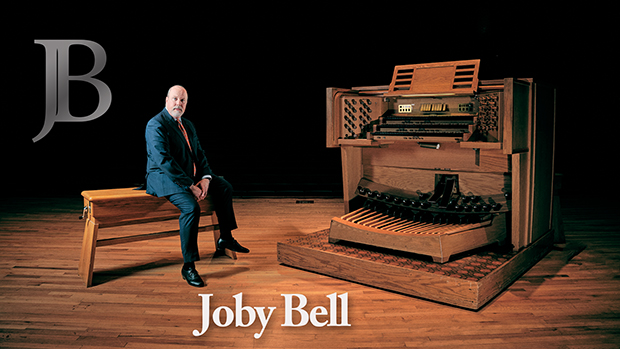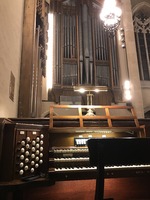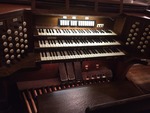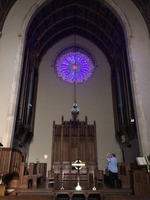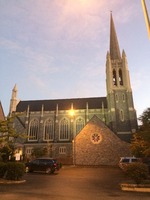Another one out of the ballpark
 Saturday, October 7, 2017 at 12:02AM
Saturday, October 7, 2017 at 12:02AM Two more “in the can!”
Producer Keith Weber, engineers Ryan Edwards and Shannon Smith, and I have just recorded the next installment of the complete Widor organ works, this time Symphonies II and III and the Suite Latine, Op. 86, recorded this week on E. M. Skinner Op. 713 (1928) at First Presbyterian, Wilmington, N.C. The following three webpages will give you a nice introduction to the organ:
In 2005 I was traveling through Wilmington with a couple students, one of whom had arranged for us to spend some time on the Skinner. As I recall, the organ was sublime, rich, full, rewarding, and in pristinely restored condition. Fast forward now to 2016, when inspired by the memory of that one encounter, I approached John Tabler, Director of Music at the church, about including this organ in the series. And here we are now. The crew and I have been enriched by this intimate encounter with a treasure of an organ located inside a most graciously appointed neo-Gothic building inhabited by some of the most hospitable staff we have encountered yet. Chalk that up to Southern hospitality if you like, but we also feel that the church and her staff are well aware of the treasure that resides inside those two chambers. We were welcomed with open arms by all we encountered but especially by John Tabler, who has expressed his thanks to us for thinking of this organ to present to the wider listening audience, with its first-ever commercially released recording. In return, I’m planning to play a recital there in May, and I’m sure I’ll include some movements from this project.
That’s the good news. But now imagine my surprise to recall in photographic evidence, only two weeks before arriving to record, that this organ has ZERO general pistons and only ONE coupler reversible [Great to Pedal (toe)]. There are four divisionals per division, save the Swell, which has five. Pedal divisionals may be activated by corresponding manual divisionals, but NO piston other than the reversible just mentioned operates ANY couplers. The coupler rail is set mercifully low and easily accessible, just above the Swell. But ZERO general pistons! With an organ from 1928, I should have known as much. [But hey, its sister instrument at St. Paul’s in Winston-Salem has TWO whole Generals.] And so all my careful piston planning in the scores had to be thrown out, less than two weeks before recording. I re-thought all stop changes, and then we had to find console assistants for the sessions, which we did, thanks to quick work by John Tabler and others. We enjoyed the gracious console assistance of Angela Daughtry and Gregory Gore, for which we are eternally grateful. Angela ended up with the hardest movements, simply by luck of the draw, and she, a non-organist, rose to the occasion admirably. She now knows intimately what “Great 4” is and how to insert her hand among mine to punch Choir pistons with the third finger of the left hand vs. getting Swell pistons with the thumb of the right. She also knows where the Choir to Pedal tab is and how tricky it is to avoid my hands when reaching for it. God bless her and her house. We have emerged victorious.
In the absence of Generals, one is constantly planning ahead. “Build the Great here, so that it will be ready in ten measures. Coupler here. Super coupler there. Catch Swell 2 here before going to the Choir.” And so forth, bit by bit, building here, reducing there. My scores are littered with incremental stop-change markings. But I would say that this process gets one more intimately involved in the “management” of the organ, as opposed to the somewhat cold, detached, lightning-quick changes we’re used to with Generals. Doing things the way that was considered state of the art in 1928 was eye opening and a much appreciated lesson this week. Although I wouldn’t complain if a future re-build added a few Generals, I will always hail this organ as imminently usable for all music, one way or another.
This organ is in excellent shape, tuning, voicing, and everything else. Everything on the console works, and every stop is just right. It’s just beautiful. When one spends this much time on a true E. M. Skinner, one discovers at every turn just how much of his console and chest designs, layout, and other elements remained in force through the remainder of Aeolian-Skinner’s existence. Skinner deserved his accolades, and although voicing and specifications changed over the years, there remained a lot of his influence on organ design in the company.
The real victory was in matching rep to organ. Once again, we have hit one out of the ballpark, and the finished product (which should be released in 2019 or so) should be thrilling to listeners. The entire project evolved, and we have chosen to record on Aeolian-Skinners (and this E.M. Skinner) that have not been “messed with” very much and yet have inexplicably not been recorded on very much. While some would record all this French music in France or at least on unabashedly French-aesthetic organs, we have chosen to use some of America’s own landmark instruments for this project, and we continue to be glad we did. The instruments are “speaking French” well, and the music on these organs is certainly speaking to our very souls in the playbacks. We have enjoyed the grandeur and the power of Symphonies VI and romane on the monumental Aeolian-Skinner in St. Mark’s Cathedral in Shreveport. We have enjoyed the solid yet elegant readings of Symphonies I and V as rendered on the Aeolian-Skinner at First Presbyterian in Houston. And now we have thrilled to a most profound 8-foot fullness in Wilmington for Symphonies II and III and the Suite Latine.
Want more about this organ? I thought so: Every stop on this organ has a job, and no stop is redundant or useless. If you look at the spec, you’ll see that the organ has everything you’d ever want. Even if you feel like you are starving for mutations and mixtures, somewhere is a stop that will give you all the color you need, whether by itself or in clever combination with another. The Pedal Trombone was a 2003 addition, narrated here (see if you can read that paragraph without choking up just a little). And the Diapasons are to DIE for: an 8-foot on the Swell, and I and II on the Great. Swell and Choir have full 73-note chests on ALL stops [whereas twenty years later, Aeolian-Skinner was extending only 8- and 4-foot stops]. There was a weird winding issue in the Choir, where it sounded like that division was speaking from behind a box fan turned up to high speed. At the console, it was troubling, but through the microphones, it was “charming,” as producer Keith puts it. When Thompson-Allen visits soon, they will address that. Then there was that squeak in the Swell box, but Keith said, rightly so, "The squeak doesn't have the fullness of the pipes, and so we don't hear it in the microphones!" Sage observation, and a relief at the console. Finally, we’ve all heard beautiful organs and beautiful rooms, but this particular marriage was made in heaven. This organ just seems to like being in this particular room, and the whole experience continued to inspire us all, all week long.
In our time, this organ has had three major, faithful stewards under its spell: Charles Woodward (whom we can thank for the first restoration in the 1970s), Douglas Leightenheimer, and now John Tabler. Faithful stewards indeed; may they ever prosper, and may this organ serve its listeners for many more Skinner-length lifetimes.
 Joby Bell | tagged
Joby Bell | tagged  Widor recordings
Widor recordings 